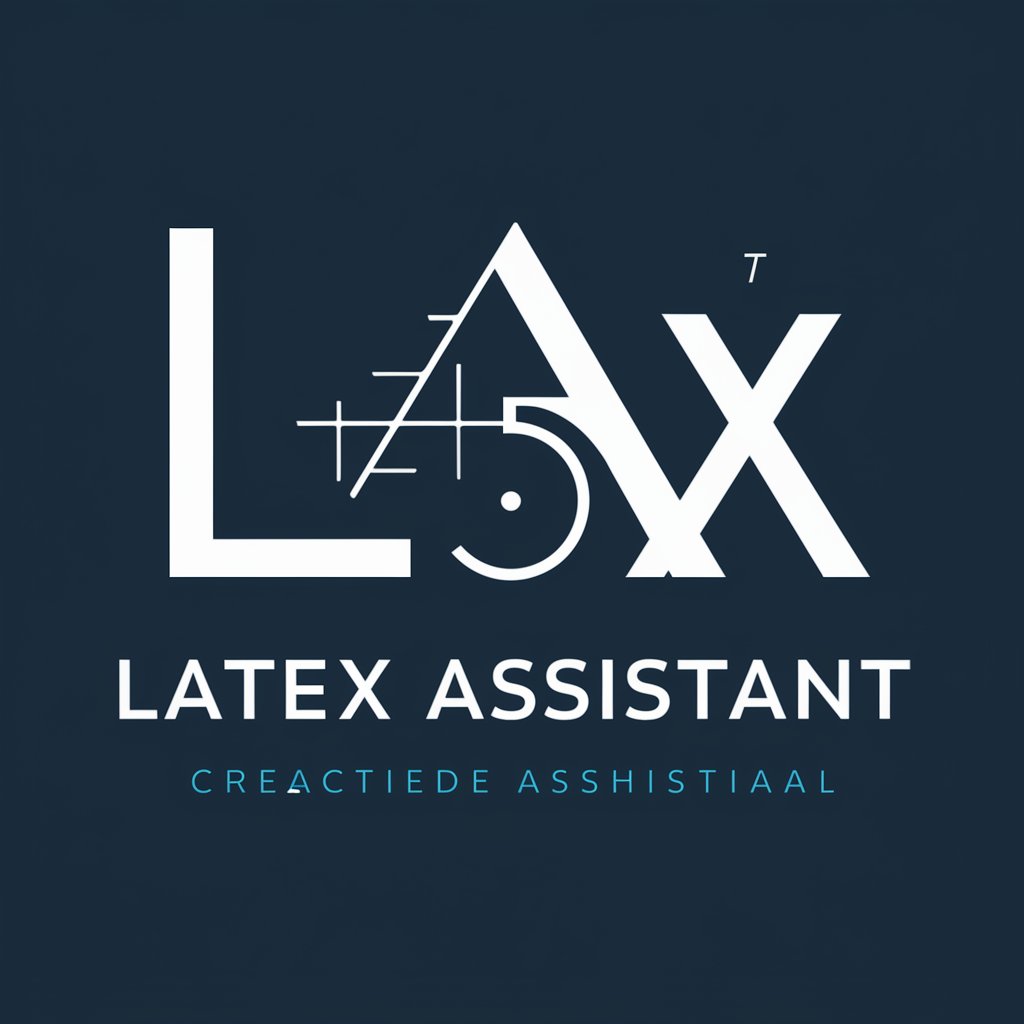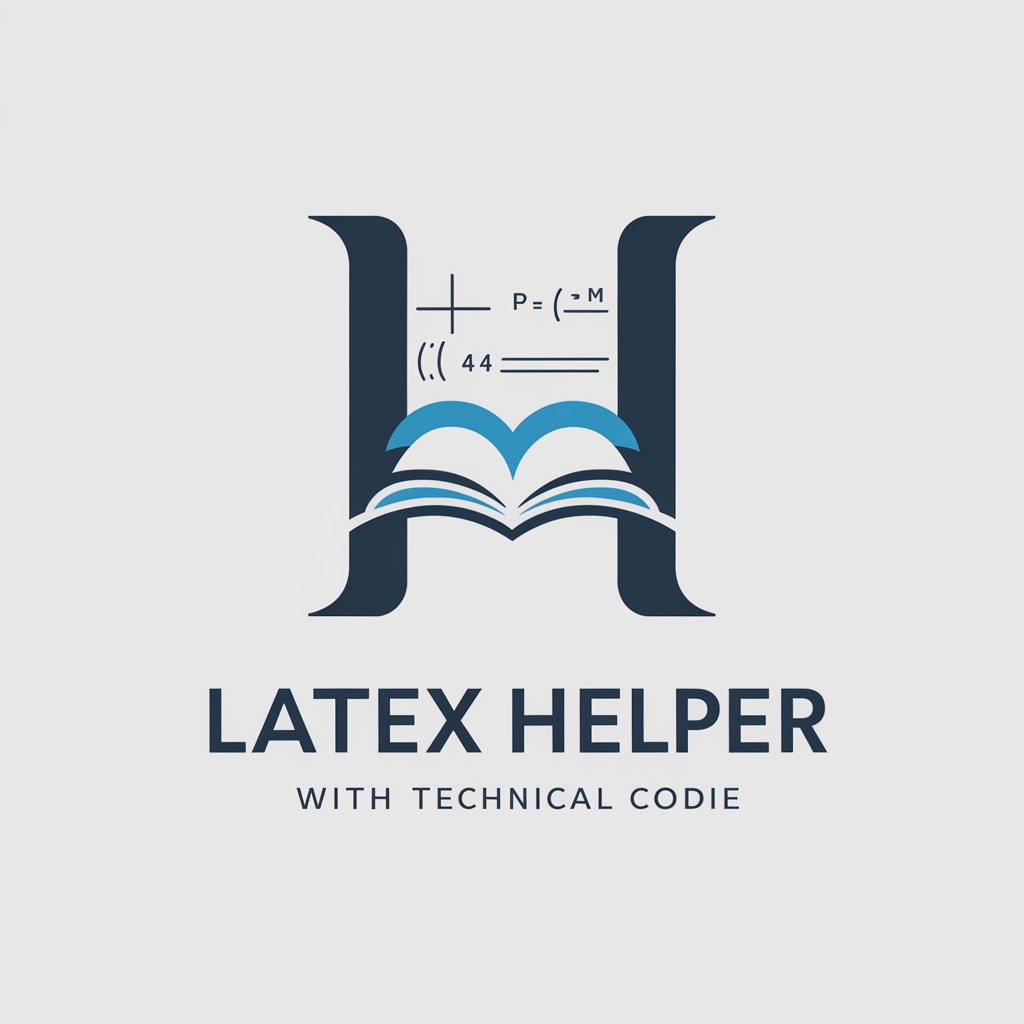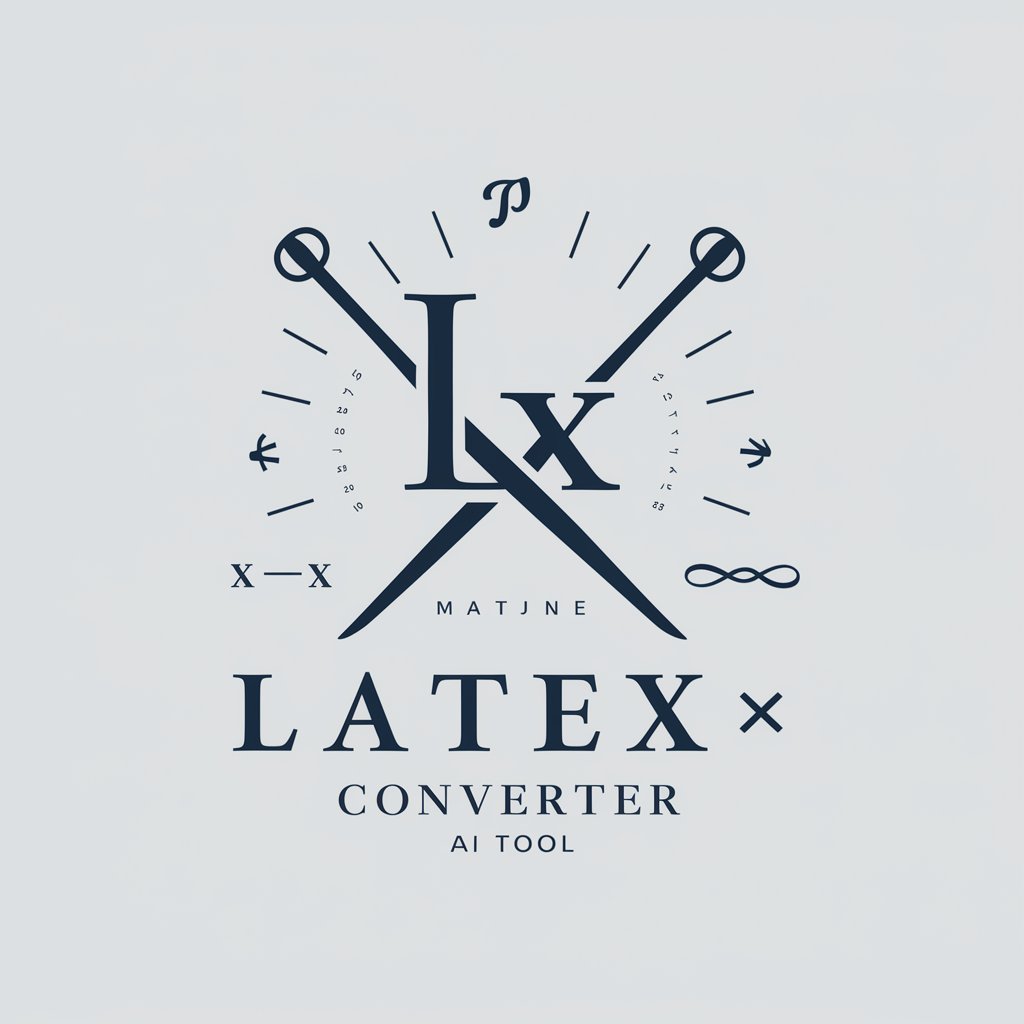
LaTeX - LaTeX editor for technical writing

🟣 Advanced LaTeX expert that converts any content inside text, images (even handwriting), or files like PDF into LaTeX expressions.
AI-powered LaTeX editor for professionals
⚡️ Convert a text/image/doc into LaTeX
✏️ How to write a fraction in LaTeX?
⌨️ Type the LaTeX code for a matrix
💡 Explain to me how LaTeX works
Get Embed Code
Introduction to LaTeX
LaTeX is a high-quality typesetting system, designed for the creation of professional documents, particularly those that contain complex mathematical expressions. Originally created by Leslie Lamport in 1984, LaTeX builds on top of the TeX typesetting system developed by Donald Knuth. Its primary purpose is to separate content from formatting, allowing users to focus on writing while the system handles the precise layout. This feature makes it particularly useful for technical and academic papers, theses, books, and articles, where mathematical formulas, references, and citations are frequently used. LaTeX excels in producing documents where the appearance of complex structures like tables, equations, and bibliographies is critical. It ensures consistency across large documents and is widely used in academia, particularly in fields such as mathematics, computer science, and physics. Unlike word processors, LaTeX uses plain text files to define the structure and content of a document, and then compiles it to produce beautifully formatted outputs such as PDFs. This system offers much more control and precision over the final document, which is why it is preferred in scenarios where document quality and layout precision are essential. For example, when creating scientific research papers, LaTeX ensures that figures, tables, and equations are neatly arranged without manual tweaking, making the editing and revision process more efficient. Powered by ChatGPT-4o。

Main Functions of LaTeX
Mathematical Typesetting
Example
LaTeX allows for precise representation of complex mathematical expressions, like $E=mc^2$, integrals, or matrices. For example, the code for a quadratic equation would look like this: \[ax^2 + bx + c = 0\].
Scenario
In scientific papers, especially in disciplines like physics, mathematics, and engineering, researchers need to include complex equations. LaTeX ensures that these equations are consistently formatted and professionally presented. A professor writing a research paper would use LaTeX to format derivations, integrals, and multi-line equations with ease.
Bibliography Management
Example
LaTeX offers packages like BibTeX to manage citations. A reference can be cited in the text using \cite{key}, and LaTeX automatically formats it in the bibliography section.
Scenario
In an academic journal article, authors may need to reference dozens of sources. LaTeX simplifies this by automatically organizing and formatting the bibliography according to the journal’s citation style. This is especially useful in fields where citation standards like APA or IEEE must be strictly followed.
Cross-Referencing
Example
With LaTeX, you can cross-reference sections, equations, and figures easily using \label{key} and \ref{key}. For example, 'see Figure \ref{fig1}' will automatically insert the correct figure number.
Scenario
A researcher writing a long thesis may need to refer to different figures, sections, or tables multiple times. Using LaTeX, they can ensure that cross-references are dynamically updated if sections or figures are moved or renumbered.
Tables and Figures
Example
LaTeX makes it simple to include tables and figures using environments like \begin{table} and \begin{figure}. You can specify captions, labels, and formatting for professional presentation.
Scenario
In an engineering report, tables containing experimental data or graphs of results are crucial. LaTeX allows for exact placement and ensures that all tables and figures are consistently formatted with proper numbering and captions.
Document Structuring
Example
LaTeX provides built-in commands for structuring documents like \chapter, \section, \subsection. These commands automatically number sections and create a table of contents.
Scenario
In writing a book or a Ph.D. thesis, organizing content into chapters and sections is essential. LaTeX ensures that the table of contents is generated automatically and updates itself as the document evolves.
Ideal Users of LaTeX
Academics and Researchers
LaTeX is extensively used by professors, graduate students, and researchers in fields like mathematics, physics, computer science, engineering, and economics. These users benefit from LaTeX’s ability to handle complex formulas, citations, and long documents like theses or journal papers. The precision, consistency, and automation that LaTeX provides are crucial for ensuring that academic papers meet high publication standards.
Publishers and Book Authors
Authors who need to produce high-quality books, technical manuals, or textbooks often turn to LaTeX for its superior typesetting capabilities. Publishers working on scientific texts, where equations, figures, and citations are prevalent, prefer LaTeX for its precise control over layout and formatting. LaTeX is also ideal for creating multi-chapter books with automated table of contents, indexes, and cross-references.
Students in Technical Fields
Graduate and postgraduate students in technical fields often use LaTeX for writing their dissertations, assignments, and research projects. The software's ability to easily handle equations, manage references, and structure large documents makes it invaluable for students working on complex academic work.
Technical Writers
Technical writers producing documentation for software, engineering, or scientific products benefit from LaTeX’s formatting control. Whether it’s creating detailed reports, instruction manuals, or reference documents, LaTeX allows technical writers to maintain consistency in formatting and cross-referencing within large, complex documents.
Journal Editors and Typesetters
Journals in scientific, mathematical, or engineering domains rely heavily on LaTeX for article formatting and typesetting. Editors and typesetters use LaTeX to ensure that submissions adhere to the strict layout guidelines required by academic journals. LaTeX also provides tools for handling large numbers of references, figures, and tables, which is common in scholarly publishing.

How to Use LaTeX
Step 1
Visit yeschat.ai for a free trial without login, also no need for ChatGPT Plus.
Step 2
Ensure you have a LaTeX editor installed, such as Overleaf (online) or TeXShop (offline). These platforms simplify compiling LaTeX code.
Step 3
Start by structuring your document with commands like \documentclass{} and \begin{document}. Add sections, equations, and references as needed.
Step 4
Use LaTeX packages like amsmath for mathematical formatting, or graphicx for images. Ensure the right packages are loaded using \usepackage{}.
Step 5
Compile your document frequently to check for errors, using the 'Compile' button (for online editors) or a keyboard shortcut (like Cmd+B on TeXShop).
Try other advanced and practical GPTs
Dominant Girlfriend
AI-Powered Virtual Girlfriend for Playful Interaction

JSON
AI-powered JSON made simple

Microphage-1
AI-driven writing for optimal UX

Jest Test Builder
AI-generated tests for smarter coding

SQLite
AI-powered database management made simple

PDF Summarizer
AI-powered PDF analysis and summaries

Cố Vấn Nhân Sinh
AI-driven insights for life improvement

Architecture Design Photorealistic Studio
AI-powered photorealistic architecture design

ThepExcel GPT
AI-Powered Excel and Power BI Assistance.

Football GPT
AI-powered football insights at your fingertips

日本語LINEスタンプメーカー
Create custom LINE stickers with AI.

Speak AI: English Conversation Practice&Writing
AI-powered tool for mastering English

Frequently Asked Questions About LaTeX
What is LaTeX mainly used for?
LaTeX is a typesetting system widely used for academic and scientific documents, including research papers, theses, and technical reports. It excels in rendering complex mathematical formulas and creating well-structured, professional documents.
Is LaTeX difficult to learn?
While LaTeX has a learning curve, especially for beginners, there are many resources available, including templates, guides, and online tutorials. With practice, users can efficiently create high-quality documents.
Can I use LaTeX for presentations?
Yes, you can use LaTeX to create presentations with the Beamer class. This allows you to design slides with mathematical formulas, images, and animations, all in a structured and professional manner.
How do I add references in LaTeX?
To add references, you can use BibTeX or the \bibliography{} and \cite{} commands. BibTeX helps manage citations and bibliographies, making it easier to format references according to various citation styles.
What are the advantages of using LaTeX over word processors?
LaTeX offers superior control over document formatting, especially for documents with mathematical content, figures, and citations. It separates content from presentation, allowing consistent formatting and automatic numbering for sections, equations, and references.





